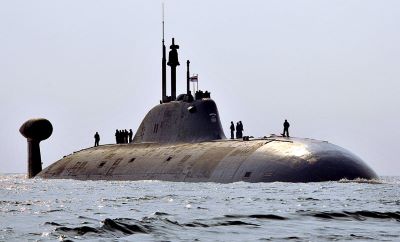Context-
In recent developments, the Indian Navy showcased a formidable display of strength by deploying 11 out of its 16 conventional submarines simultaneously in the Indian Ocean. However, this exhibition of naval prowess also sheds light on the dwindling submarine fleet of India. The operational challenges are evident as several submarines undergo refits or repairs, impacting the fleet's overall strength.
Operational Composition of Indian Submarine Fleet
India's submarine fleet comprises various classes, including the Kalvari-class (French Scorpene), Shishumar-class (German Type-209), and Sindhugosh-class (Russian Kilo) submarines. As per the International Institute for Strategic Studies’ Military Balance 2024 report, India currently operates 16 operational submarines, with plans to commission another Kalvari-class submarine soon, bringing the total to 17.
● Kalvari-class submarines: 5 operational, with one more to be commissioned.
● Shishumar-class submarines: 4 in operation, noted for reliability and performance.
● Sindhughosh-class submarines: 7 operational, facing challenges with operational availability.
Classification of Submarine-
|
Submarine Classification |
Description |
Examples |
|
Diesel-Electric Submarines (SSK) |
Use electric motors charged by diesel engines. Need to resurface frequently for air and fuel. |
Shishumar Class (built in collaboration with Germany), Kilo Class (from Russia), Kalvari Class (P-75) |
|
Nuclear-Powered Attack Submarine (SSN) |
Can operate underwater almost indefinitely. Equipped with tactical weapons. |
INS Chakra 2 (leased from Russia) |
|
Nuclear-Powered Ballistic Missile Submarine (SSBN) |
Serve as stealthy launch platforms for nuclear weapons. Part of Strategic Forces Command. |
Arihant , three more SSBNs are under construction |
Challenges in Fleet Availability
While newer submarines like the Kalvari class boast higher availability ratios, older vessels such as the Russian Kilo-class submarines face diminishing availability due to their vintage. The Russian Kilos, operational since the 1980s, are nearing decommissioning, exemplified by the decommissioning of INS Sindhudhvaj in 2022 and the loss of another submarine in 2013. Despite efforts to extend service life through refurbishments, the operational availability of Russian submarines remains a concern.
Procurement Delays and Future Plans
India's plans to augment its submarine fleet face considerable delays, with proposals for additional advanced submarines facing a delay of up to ten years. Efforts to procure new submarines through intergovernmental deals with Germany and Spain are underway. The Indian Navy's criteria for the P-75I submarines prioritize advanced features such as Air-Independent Propulsion (AIP), aiming to enhance operational capabilities.
● Proposal for 6 advanced submarines facing a decade-long delay.
● Competition between Germany and Spain for the $5 billion-plus deal.
● Criteria include advanced features like AIP to ensure prolonged submerged operations.
Procurement Prospects and Technological Considerations
The procurement process for new submarines involves evaluating technological capabilities and ensuring adherence to strategic objectives. With Germany and Spain vying for the lucrative submarine deal, considerations such as technological transfer, efficiency of AIP modules, and governmental assurances play crucial roles in the decision-making process.
Competing Proposals from Germany and Spain
Thyssenkrupp Marine Systems (TKMS) of Germany and Navantia of Spain, along with their respective Indian partners, are in contention for the submarine contract. While both proposals offer advanced submarine designs, Navantia's agreement includes complete technology transfer and is backed by governmental guarantees, providing reassurance to Indian authorities.
● Efficiency of Navantia's AIP module enhances operational capabilities.
● Spain's partnership with Indian firm Larsen & Toubro strengthens indigenous capabilities.
Technological Considerations for Enhanced Capabilities
India's strategic imperatives necessitate submarines capable of prolonged submerged operations. The adoption of AIP technology is paramount to achieving this objective. Navantia's AIP module, touted for its efficiency, aligns with India's requirements for extended underwater endurance.
Future Naval Expansion and Strategic Imperatives
India's aspirations for a robust naval fleet are driven by strategic imperatives, including maritime security in the Indian Ocean region (IOR) and the evolving geopolitical landscape. However, achieving ambitious fleet targets by 2030 and beyond necessitates overcoming budgetary constraints, scaling issues, and operational challenges.
India aims to bolster its naval fleet to around 155-160 warships by 2030, encompassing submarines, aircraft carriers, destroyers, frigates, and other vessels. This expansion aligns with broader maritime strategies aimed at enhancing naval capabilities and ensuring maritime security in the IOR.
Constraints and Challenges
Despite ambitious expansion plans, India faces several constraints, including budgetary limitations and scaling issues. The procurement process is often hindered by delays, while indigenous production capabilities struggle to keep pace with naval requirements. Furthermore, the evolving geopolitical landscape, particularly China's growing maritime power, underscores the urgency to bolster naval capabilities.
Long-term Vision and Adaptation
Looking ahead to 2035 and beyond, India envisages a fleet size of at least 175 warships, with potential scalability to 200 vessels. This long-term vision underscores the need for sustained investments in naval infrastructure, technological advancements, and strategic partnerships to ensure credible strategic reach, mobility, and flexibility in the IOR and beyond.
Conclusion
India's submarine saga highlights the challenges and imperatives facing its naval expansion efforts. Despite recent displays of strength, the dwindling submarine fleet underscores the urgency to address operational constraints and expedite procurement processes. The competition between Germany and Spain for the submarine deal underscores the significance of technological considerations and strategic partnerships. As India navigates budgetary limitations and geopolitical complexities, sustained investments and long-term vision are essential to realizing its ambitions for a formidable naval fleet capable of safeguarding its maritime interests in the Indian Ocean region and beyond.
|
Probable Questions for UPSC Mains Exam- 1. How do the procurement delays and operational challenges faced by India's submarine fleet impact its ability to maintain maritime security in the Indian Ocean region? (10 Marks, 150 Words) 2. What strategies can India employ to overcome budgetary constraints and scaling issues in order to achieve its ambitious fleet expansion goals by 2030 and beyond? (15 Marks, 250 Words) |
Source- ORF







